Digital transformation may sound easy, but it’s not. Currently there are so many different perception of this buzzword around the world.
Off course it’s a journey which will change with the technologies you adopt and also bring it to the people, processes and culture associated with your company. But before understanding this buzzword, it is important to know what not a Digital Transformation is.
Many organizations are misunderstanding the digital transformation.
· Digitization — Integrating Digital Technologies into Workplaces [like use of mobile, easy accesses, gadgets]. It is the process of changing from analog to digital form
· Agile and DevOps — Technology Makeover with development engineers participating together in the entire service lifecycle, from design through the development process to production support or using AGILE methods to move quickly and easily
· Business Process Optimization — To enhance process for more efficient results and outcomes.
· Digitalization — The use of digital technologies to change a business model and provide new revenue and value-producing opportunities; it is the process of moving to a digital business.
But for many organizations, digital transformation is really digital optimization in disguise, as new digital initiatives merely augment existing services.
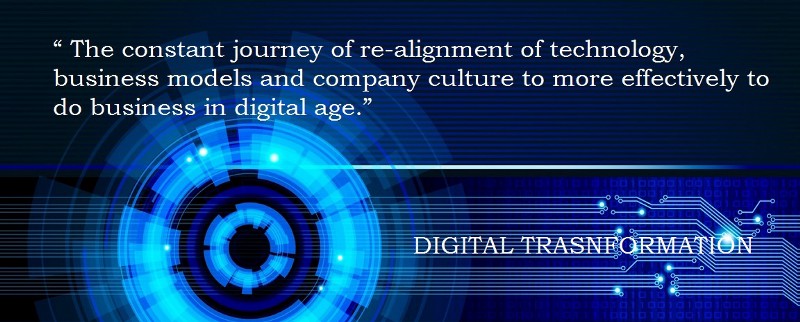
“Digitalization” open the way towards the transformation journey. The Digital Transformation leverage enormous opportunities for innovation and competitive advantages, which will require a complete rethinking of the organization: cultural, strategic, technological, operational changes which lead to a transformation.
And we need to focus on the following drivers and capabilities to keep the journey going.

Focus should be on re-alignment of business models based on your vision, focus should be on your customer experiences, your users, on your existing processes, enablement of technologies to support these, driving by agile leadership (must be flexible enough to change decision) and respect to the company culture.
Please note more than 70% of the digital transformation projects/programs don’t succeed
Mckinsey suggests that 70% of transformation programs fail, while Forbes puts the figure at 84%. Genpact states the rate of failure is at 75%, which implies that 2 out of every 3 digital transformation projects/programs fail.
Why? First and the foremost question, do you have a clear view? Or it’s an ICEBERG?
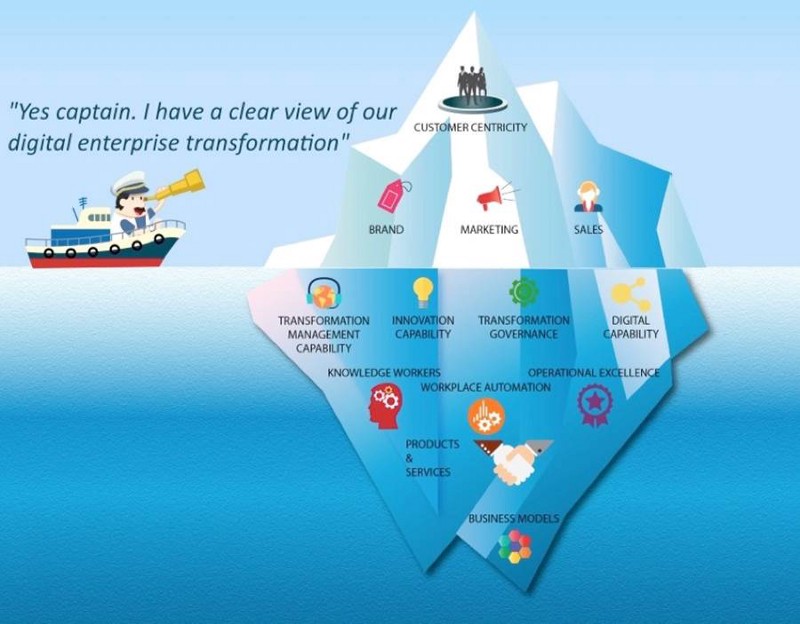
So what do we need to know to see a clear view?
Mindset
We need to have the right mindsets for the transformation, an adopting mindset in fact. WE NEED TO ADOPT! Starting with you personally, with your organization, your customers and the rest of the context (like the industry, technologies, demographics etc.) which is in fact related to your transformation.
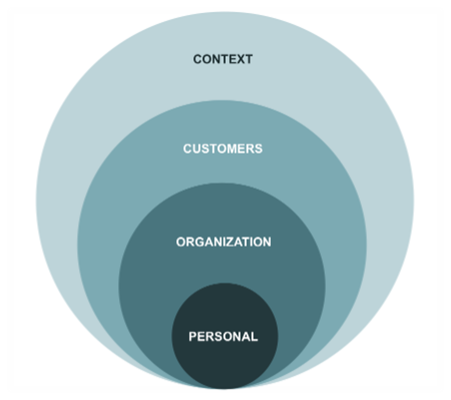
The first step to start with is to ask questions with open-minded attitude so that we can open a new world of opportunities.
· Why do we need to transform?
· What does a successful transformation look like?
· Do we have the right skills and resources?
· Are we aware of challenges?
· Is the organization ready for the changes?
These are some the basic question we must start with to understand the journey. A mindset refers to a person’s established set of attitudes about a topic, including digital.
Take a look into the research from SAP with collaboration with Oxford Economics on The Digital Transformation Mindset That Matters Across Geographies
And what is the number one hurdle to digital transformation?
It’s the CULTURE, the operating system of the organization. Companies from the pre-digital era therefore need to adjust or shift their organizational culture to keep up in today’s digital world. Company also must be ready to adapt their culture or change in culture. Neither it is easy nor is it going to happen so fast.
Company culture reflects an organization’s deepest and most tightly held beliefs and values. Those beliefs and values have had years and often decades to become deeply entrenched and often played a significant role in why the organization reached its level of success in the first place.
Moreover there are individual cultures, a different culture for different teams. All must be sync or fit each other for the success.
Building a culture of constant change — a state of constant revolution is a key.
BEWARE: Mindset is the first hurdle in digital transformation journey
Strategy
It is the Strategy which drives the digital transformation not Technologies. Digital transformation is no longer just an add-on feature to existing channels or products and services. Instead, many aspects of the customer experience are digital by default, as should be the processes that underpin it.
Most important thing is to capture the value and finding the sweet spots (among company’s capabilities, customer’s need, competitor’s offering). You need to consider the entire value chain when making the strategy. Then only you get ready for the digital transformation.
Strategy has no value without execution. And important is you have execute it, and this a in fact an agile process. Analyse, Formulate and Building. And it is in fact a constant improving process. It’s not like you set something and forget about it. Nobody cares about strategy! Or sometimes people are so much caring they are not ready to change whatever they decided in the beginning. This is not working at all for strategy.
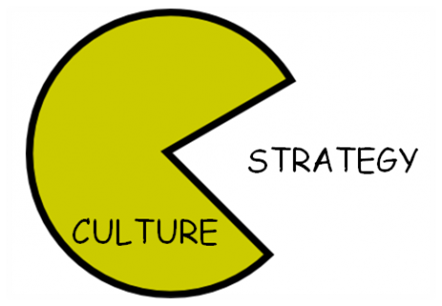
BEWARE: Culture eats Strategy in Breakfast.
Leadership
Any business can excel at digital leadership and management, regardless of its size or budget. But doing so requires more than just savvy IT leaders.
“So who owns digital transformation?”
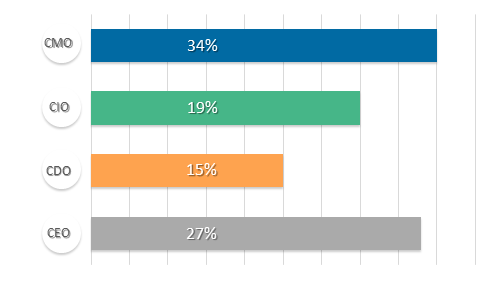
“What should we expect from the leader who is leading a digital transformation?”
Clear on Vision, Keeping Transparency with all, Believe in Collaboration, Possess Agility, Strong in Communication, A perfect Role Model are some the very important qualities we should expect at least.
BEWARE: Culture, leadership, and strategy are the triumvirate that together steer the organization toward excellence.
People
We know about customer first approach, customer is the king, the god. Off course we do know and we do agree. Especially we must put attention on the customer experience when we are considering a digital transformation. But that’s not enough.
Digital transformation means different things to different people. For many, it’s about the speed and power of back office technology. For some, it’s about getting more visibility into process and data. For others, it’s about driving efficiency and cost savings to the bottom line.
Digital transformation, people align with and people transformation in the same time. It can be the customer, partners/vendors/suppliers or even your employees. Everybody is equally important for the whole transformational experience and equally responsible for the success.
What is important here is the EMPATHY: the ability to understand and share the feelings of another and “…To address people needs, there is a need to empathize with people and their emotional states when scoping and designing new solutions and services…” Digital empathy should be a core element/fuel of your digital transformation strategy.
The people must be associate with other two ingredients Process and technologies (also call as golden triangle) for the success or specifically Digital Success.
BEWARE: Empathy is a key tool for creating a digital success.
Another important aspect to remember is to not start fearing from the ongoing and the future failures. Failure is in fact the first step of success and we all have learnt that from our childhoods. Organizations that experience continued success recognize that it isn’t just the change; it is the journey that matters.
Digital Transformation is more than a buzzword; it becomes an essential part of corporate strategies. There is no alternative to digital transformation. Visionary companies will carve out new strategic options for themselves — those that don’t adapt will fail.
I had an interesting opportunity to speak on this in INNOWAVE 2017 BUSINESS & STARTUP in Varna (European Youth Capital), Bulgaria on last Oct, 2017.

I am always open to discuss on this topic anytime, and sharing thoughts and experience.
Have a great Journey!


